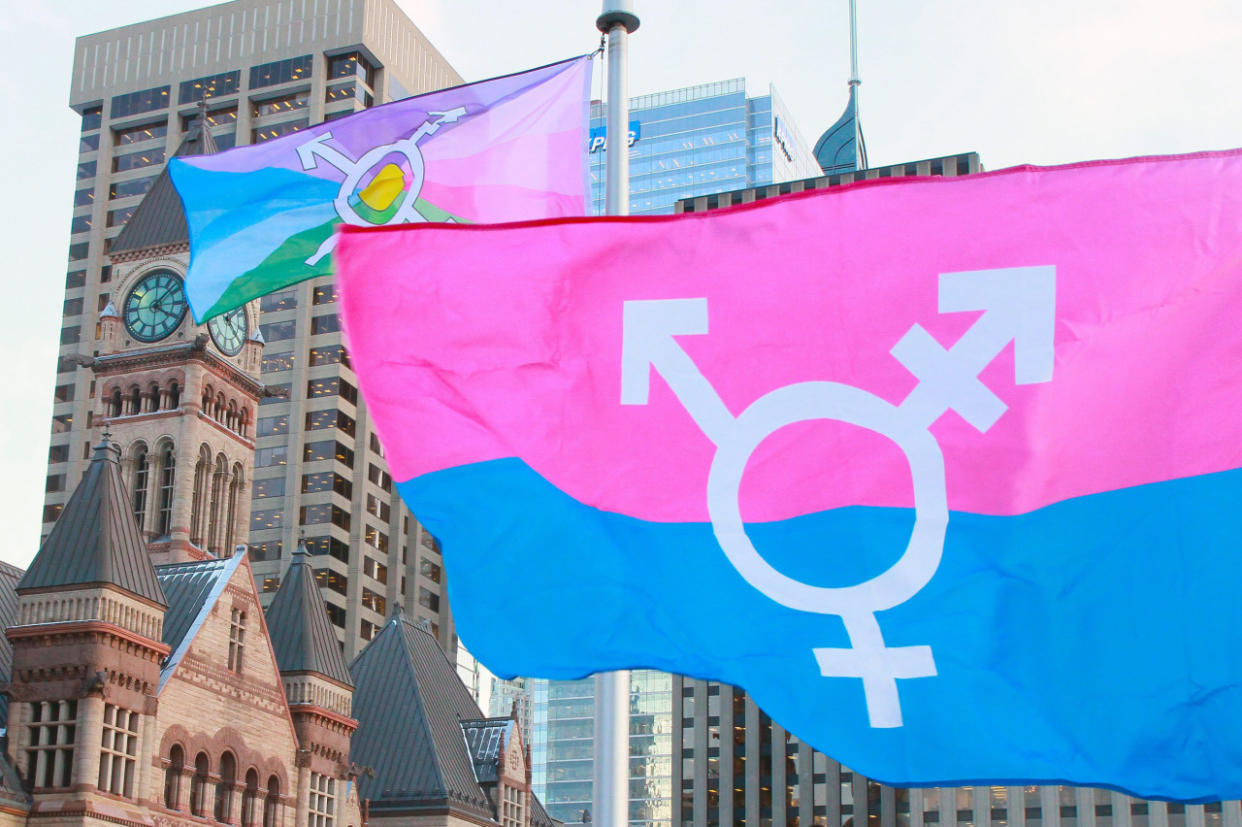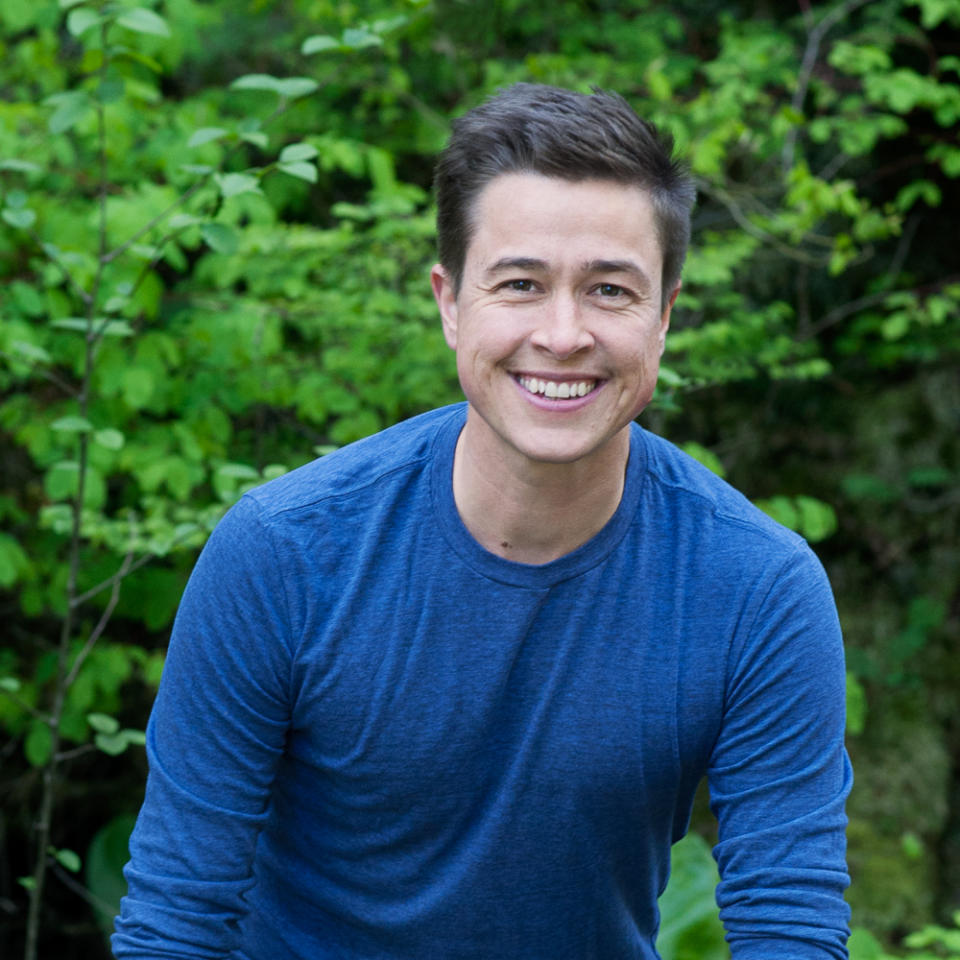Transgender, transition and the effects on the family

(The City of Toronto marks its first official Transgender Day of Remembrance with a flag-raising ceremony on November 20, 2014. Photo: Newzulu)
Kai Scott remembers being 20 years old and wanting to be a pallbearer at his grandfather’s funeral. His wish was met with puzzlement and objection by family members; carrying a casket was something girls just didn’t do. That was one of the first moments that female-born Scott realized that he didn’t identify with the gender he was assigned at birth.
The Vancouver resident had experienced a sense of being different while he was growing up; he preferred baggy pants over skirts and short hair over braids, for instance. It wasn’t until four years ago, at age 33, however, that he embarked on what he calls “a gender journey.” He now identifies as a trans man. And one of the first people he told about wanting to transition was his younger sister.
“It’s one of the most important relationships I have, and I wanted to be transparent,” says Scott, who cofounded with Drew Dennis TransFocus Consulting, which provides transgender resources to employers and policy makers. “I can appreciate it seemed to come out of nowhere, because I went through an intensive period prior where I tried to be extremely feminine ….But I wanted there to be an openness to dialogue, and I wanted Liz to be involved.”

(Kai Scott. Photo by Belle Ancell)
While going through a transition is typically an incredibly challenging time for the individual, it’s also a process that affects those near and dear to them.
Scott’s only sibling, Liz Scott, says she was indeed shocked to hear about Kai’s feelings and plans. She says she went through a period of grieving; it was hard to get used to the idea she would no longer have a sister. But while the transition hasn’t always been easy for her or her family, she has always stood by him.
“It came out of the blue, and that in and of itself was quite painful,” Liz says. “You built a relationship with someone, and especially in a sisterly context, it’s very intimate. There was a sense of loss, but that was softened by it being an inclusive journey for him and us.”
ALSO SEE: Women aren’t the only people who menstruate
Kai asked his sister if she would be his caretaker following his “top surgery” - the term for a bilateral mastectomy and shaping of a male-contoured chest, for instance.
“The way Kai was able to include me was a real act of grace,” Liz says. “It allowed me to take the transition steps with him rather than it being ‘I don’t have a sister anymore.’”
Kai Scott says that while his parents have grappled with his new identity, he and his family members have always been respectful of and compassionate with each other.
“We’re all navigating some very tough emotions,” he says. “This is very foreign to my parents, but they’re trying to come to an understanding and they’re educating themselves. It’s not necessarily something that they would choose for me, and we may not see eye to eye, but we honour each other.”

(Kai Scott. Photo: Pride Run and Walk 2015 https://vancouverfrontrunners.org)
“My mom and I took a weekend away together, and it gave her a chance to ask questions that were on her heart and mind and to dig deep to see it from my perspective,” he adds. “It warms my heart that they’re asking questions and that there’s a willingness and openness to dialogue.”
While Liz Scott found support from her husband and some members of their church throughout her brother’s transition, there are formal resources across Canada for family members and loved ones of those considering, going through, or having been through a transition.
PFLAG Canada helps people with issues of sexual orientation, gender identity, and gender expression. Its website lists several organizations that help transgender people’s relatives and friends, including TransParent Canada, Transfamilies Canada, and the LGBT Family Coalition.
ALSO SEE: How different is it to ‘come out of the closet’ in 2016?
Pride & Prejudice, which offers counselling and support to lesbian, gay, bisexual, transsexual and transgender youth and young adults in Toronto, meanwhile, has produced several research-based and community resources about LGBTQ youth. One of them is Families in TRANSition, a resource guide for parents of trans kids that covers everything from adapting to name and pronoun changes to telling other people in their lives about their child’s transition.
While a transition can be stressful for family members, much progress has been made over the years.
Gayle Roberts waited until she was 55 to transition. The first teacher from the Vancouver School Board to transition on the job, she had the support of her employer, colleagues, friends, and second wife, to whom she’s still married. (The two now refer to each other as sisters.)
ALSO SEE: Transition process full of surprising costs for transgender men and women
Yet she looks back at those years of having to conceal her gender identity as a period of anguish. She hopes that by sharing her story she may be able to offer hope and support to anyone struggling with what’s known as gender dysphoria.
“As early as four or five years old I remember wanting to be a girl,” Roberts says. “Growing up, I was too ashamed to tell my parents, and I couldn’t show them through behaviour. So everything was pressed down. I felt completely locked in. I was in a lot of psychological pain.”
Years later she went to see a psychiatrist, who told her she had multiple personalities and that a traumatic event from childhood had resulted in her desire to be female. She accepted for a time that she was mentally ill.
By the mid-80s, gender dysphoria was better understood, and Roberts began to realize that in fact she wasn’t suffering from a mental disorder. She made the decision to transition, and she says her life changed in an instant.
“When I made that realization and accepted it, within seconds, literally seconds, all that gender dysphoria completely disappeared,” Roberts says. “The reason I wanted to be a girl was not because of some trauma or because my parents screwed me up but because that’s who I am inside. That’s my gender identity. I was at peace with myself.”
ALSO SEE: The bathroom and how it has become a battleground for trans rights
While things have improved tremendously for people like her, Roberts says more needs to be done to support transgender people.
Seventy-four per cent of transgender students have been verbally harassed about their gender expression and 37 per cent have been physically harassed, according to the National Climate Survey on Homophobia, Biphobia and Transphobia in Canadian Schools, a 2011 report by Egale Canada Human Rights Trust. Youth with gender dysphoria also have higher attempted suicide rates, according to the U.S. 2010 National Transgender Discrimination Survey Report on Health and Health Care: 45 per cent for those aged 18 to 44 compared to the national average of 1.6 per cent.
“My story is not just about me; it applies to everybody,” Roberts says. “It’s so important to accept who you are and be comfortable with who you are and to have support to do that. Be who you want to be. That’s the secret of life. Be proud of who you are.”
ALSO SEE: Still a long way to go for transgender people and fertility treatment
Being himself still comes with challenges for Kai Scott. When he’s in a male change room, for example, people stare at the scars on his chest. But he says having the support of his family, and especially his sister, has made the journey easier.
For his sister’s part, Liz Scott says she has learned a great deal from being by her brother’s side.
“Now that we’ve been through this process, his voice is lower and his hormones are different, but the person I love and know hasn’t changed,” she says. “There’s always a fear they’re going to be a completely different person and that you can’t relate to them the way you used to, but that’s not the case.
“Ultimately that person is still the same person,” she adds, “and we love him.”
Have any thoughts about this article? Let us know by tweeting @YahooStyleCA.



